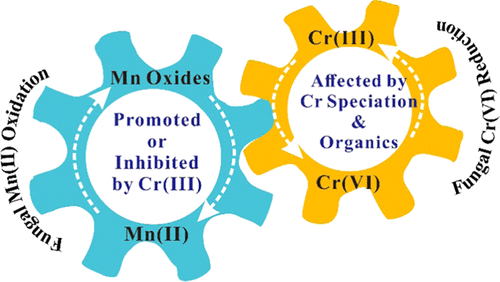当前位置:
X-MOL 学术
›
Environ. Sci. Technol.
›
论文详情
Our official English website, www.x-mol.net, welcomes your feedback! (Note: you will need to create a separate account there.)
Coupled Mn(II) and Cr(III) Oxidation Mediated by Ascomycete Fungi
Environmental Science & Technology ( IF 11.4 ) Pub Date : 2021-11-26 , DOI: 10.1021/acs.est.1c05341 Xiaolei Liu 1, 2, 3 , Hailiang Dong 3 , Colleen M Hansel 4
Environmental Science & Technology ( IF 11.4 ) Pub Date : 2021-11-26 , DOI: 10.1021/acs.est.1c05341 Xiaolei Liu 1, 2, 3 , Hailiang Dong 3 , Colleen M Hansel 4
Affiliation

|
Manganese (Mn) oxides are considered as the primary oxidant of trivalent chromium [Cr(III)] in the environment. Microbial activities are responsible for the majority of Mn oxide formation in nature, thus likely influencing Cr(III) oxidation. Previous studies have been limited to Cr(III) oxidation by bacterial Mn oxides. Herein, we report coupled Mn(II) and Cr(III) oxidation in the presence of three Mn(II)-oxidizing Ascomycete fungi. In contrast to the previously reported inhibitory effect of Cr(III) on bacterial Mn(II) oxidation, varying effects of Cr(III) on fungal Mn(II) oxidation were observed, which may be linked to their Mn(II)-oxidation mechanisms. Under the concentrations of Mn(II) and Cr(III) applied in this study, Cr(III) promoted Mn(II) oxidation if it was mediated by hyphae-associated processes, but inhibited Mn(II) oxidation if it was achieved via extracellular enzymes/metabolites. The Cr(III) oxidation rate and extent were affected by Cr(III) speciation, Cr(VI) removal capacity (i.e., adsorption/reduction) of fungi, and organic content. The morphology and spatial relationship of Mn oxides with fungi varied, depending on fungal species and Cr(III) presence. Our findings highlight the importance of Mn(II)-oxidizing fungi in biogeochemical cycles of Mn and Cr and have significant implications for the origin of geogenic Cr(VI) and stability of reduced chromium in contaminated environments.
中文翻译:

子囊菌介导的 Mn(II) 和 Cr(III) 耦合氧化
锰 (Mn) 氧化物被认为是环境中三价铬 [Cr(III)] 的主要氧化剂。微生物活动是自然界中大部分 Mn 氧化物形成的原因,因此可能影响 Cr(III) 氧化。以前的研究仅限于细菌锰氧化物对 Cr(III) 的氧化。在此,我们报告了在三种 Mn(II) 氧化子囊菌真菌存在下的耦合 Mn(II) 和 Cr(III) 氧化。与先前报道的 Cr(III) 对细菌 Mn(II) 氧化的抑制作用相反,观察到 Cr(III) 对真菌 Mn(II) 氧化的不同影响,这可能与它们的 Mn(II) 氧化有关机制。在本研究中应用的 Mn(II) 和 Cr(III) 浓度下,如果 Cr(III) 由菌丝相关过程介导,则 Cr(III) 会促进 Mn(II) 氧化,但如果通过细胞外酶/代谢物实现,则抑制 Mn(II) 氧化。Cr(III) 氧化速率和程度受Cr(III) 形态、Cr(VI) 去除能力(即吸附/还原)真菌和有机物含量的影响。Mn 氧化物与真菌的形态和空间关系因真菌种类和 Cr(III) 的存在而异。我们的研究结果强调了 Mn(II) 氧化真菌在 Mn 和 Cr 的生物地球化学循环中的重要性,并且对地质成因 Cr(VI) 的起源和污染环境中还原铬的稳定性具有重要意义。Mn 氧化物与真菌的形态和空间关系因真菌种类和 Cr(III) 的存在而异。我们的研究结果强调了 Mn(II) 氧化真菌在 Mn 和 Cr 的生物地球化学循环中的重要性,并且对地质成因 Cr(VI) 的起源和污染环境中还原铬的稳定性具有重要意义。Mn 氧化物与真菌的形态和空间关系因真菌种类和 Cr(III) 的存在而异。我们的研究结果强调了 Mn(II) 氧化真菌在 Mn 和 Cr 的生物地球化学循环中的重要性,并且对地质成因 Cr(VI) 的起源和污染环境中还原铬的稳定性具有重要意义。
更新日期:2021-12-07
中文翻译:

子囊菌介导的 Mn(II) 和 Cr(III) 耦合氧化
锰 (Mn) 氧化物被认为是环境中三价铬 [Cr(III)] 的主要氧化剂。微生物活动是自然界中大部分 Mn 氧化物形成的原因,因此可能影响 Cr(III) 氧化。以前的研究仅限于细菌锰氧化物对 Cr(III) 的氧化。在此,我们报告了在三种 Mn(II) 氧化子囊菌真菌存在下的耦合 Mn(II) 和 Cr(III) 氧化。与先前报道的 Cr(III) 对细菌 Mn(II) 氧化的抑制作用相反,观察到 Cr(III) 对真菌 Mn(II) 氧化的不同影响,这可能与它们的 Mn(II) 氧化有关机制。在本研究中应用的 Mn(II) 和 Cr(III) 浓度下,如果 Cr(III) 由菌丝相关过程介导,则 Cr(III) 会促进 Mn(II) 氧化,但如果通过细胞外酶/代谢物实现,则抑制 Mn(II) 氧化。Cr(III) 氧化速率和程度受Cr(III) 形态、Cr(VI) 去除能力(即吸附/还原)真菌和有机物含量的影响。Mn 氧化物与真菌的形态和空间关系因真菌种类和 Cr(III) 的存在而异。我们的研究结果强调了 Mn(II) 氧化真菌在 Mn 和 Cr 的生物地球化学循环中的重要性,并且对地质成因 Cr(VI) 的起源和污染环境中还原铬的稳定性具有重要意义。Mn 氧化物与真菌的形态和空间关系因真菌种类和 Cr(III) 的存在而异。我们的研究结果强调了 Mn(II) 氧化真菌在 Mn 和 Cr 的生物地球化学循环中的重要性,并且对地质成因 Cr(VI) 的起源和污染环境中还原铬的稳定性具有重要意义。Mn 氧化物与真菌的形态和空间关系因真菌种类和 Cr(III) 的存在而异。我们的研究结果强调了 Mn(II) 氧化真菌在 Mn 和 Cr 的生物地球化学循环中的重要性,并且对地质成因 Cr(VI) 的起源和污染环境中还原铬的稳定性具有重要意义。


























 京公网安备 11010802027423号
京公网安备 11010802027423号